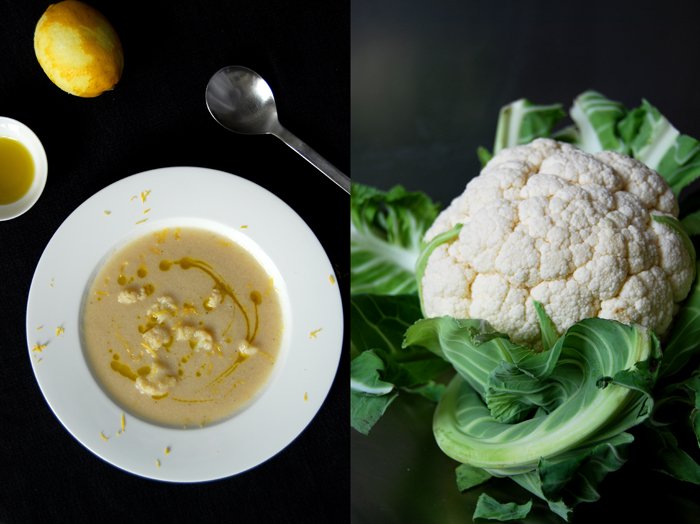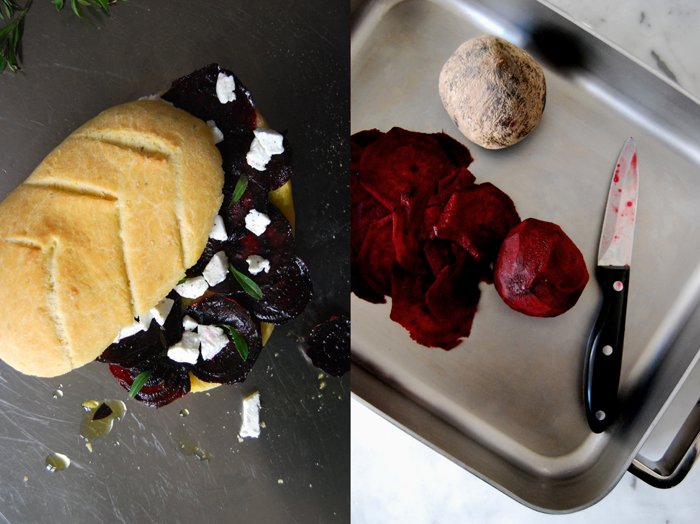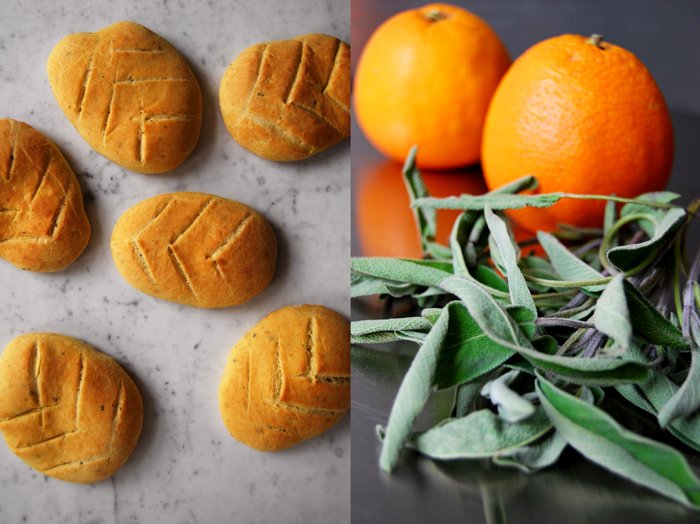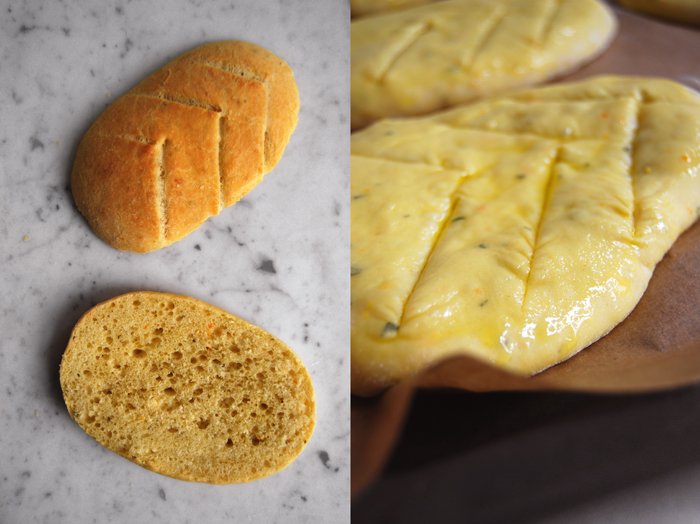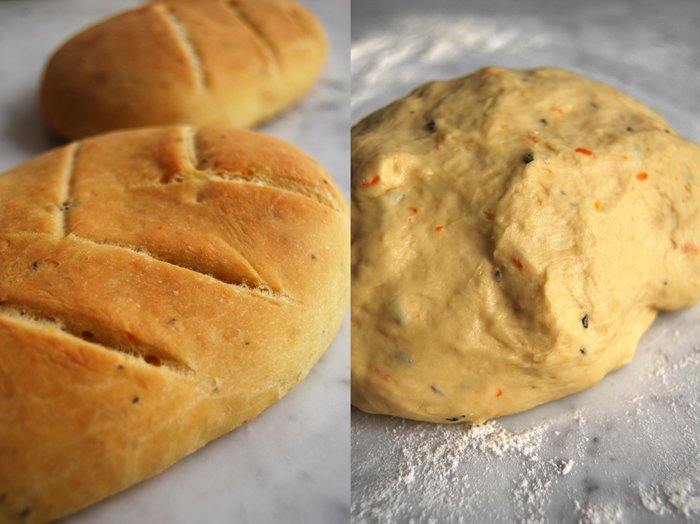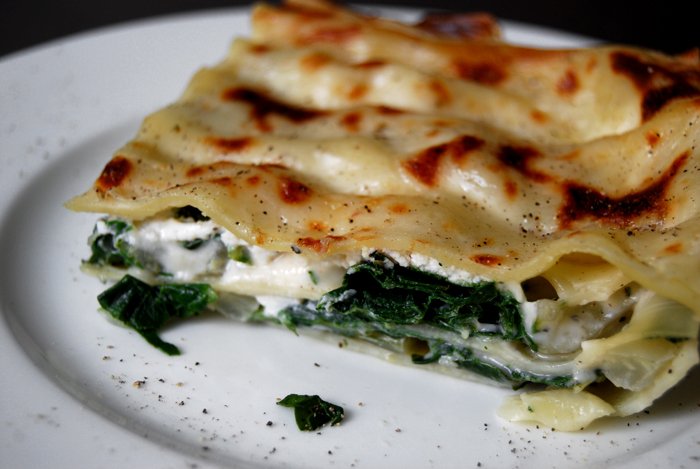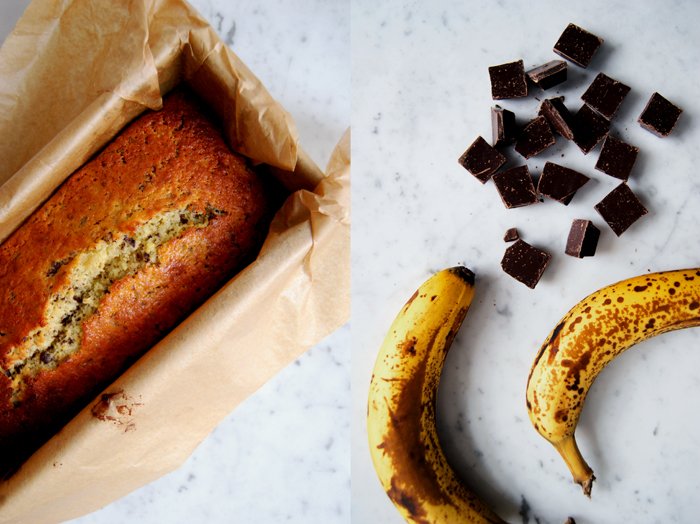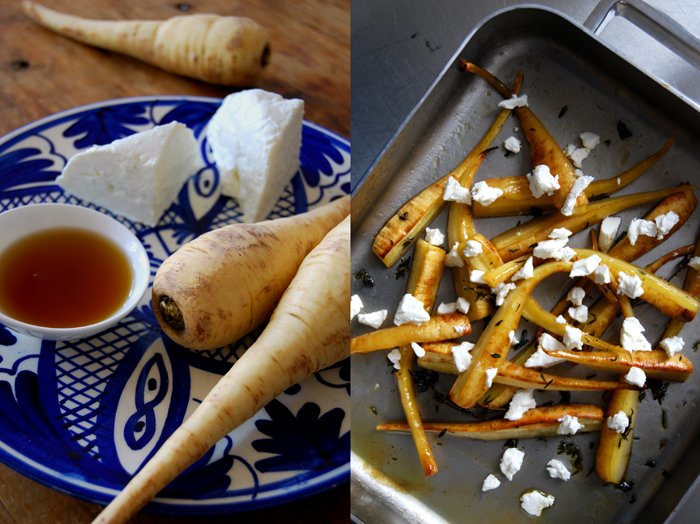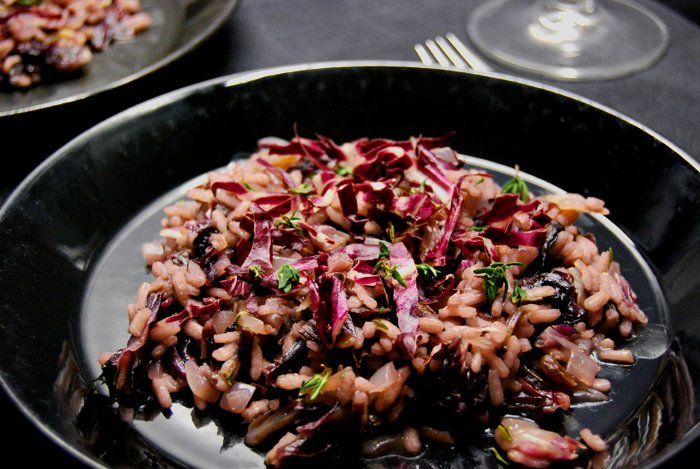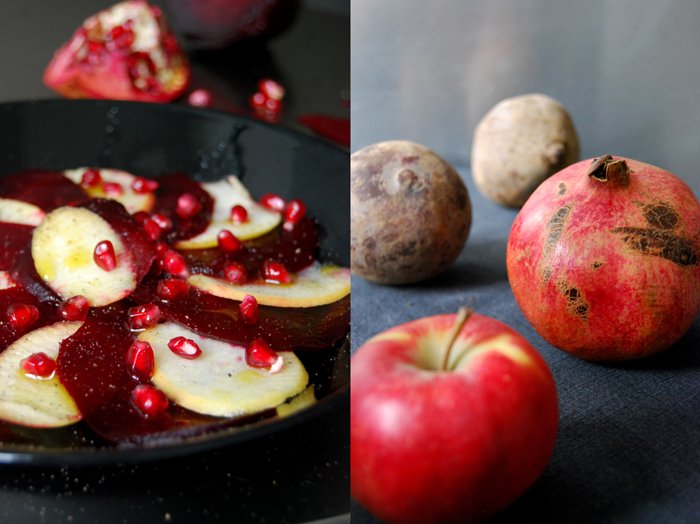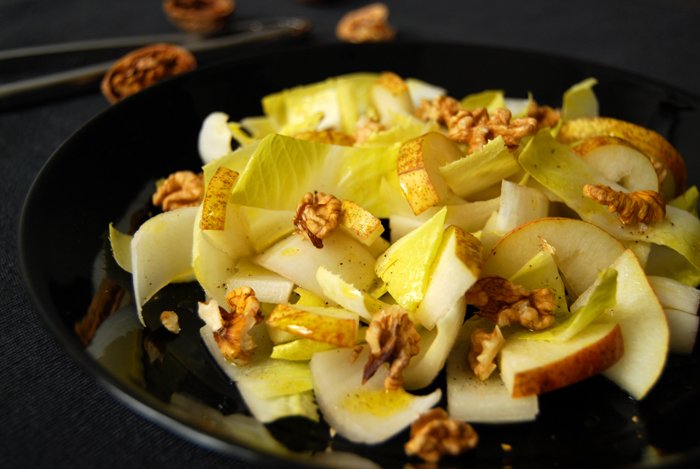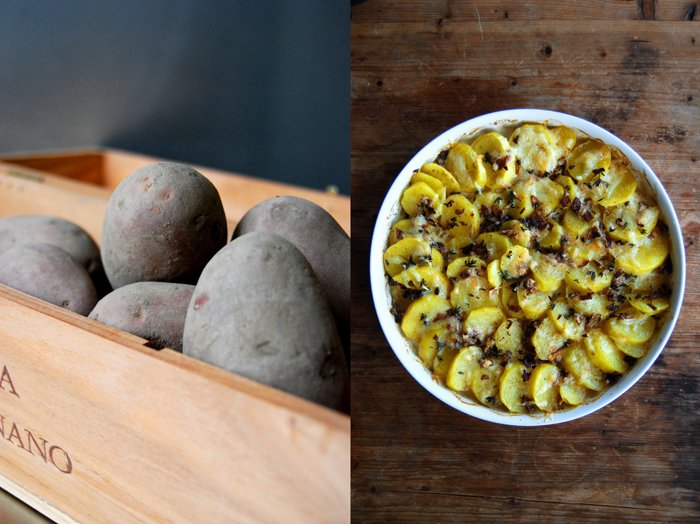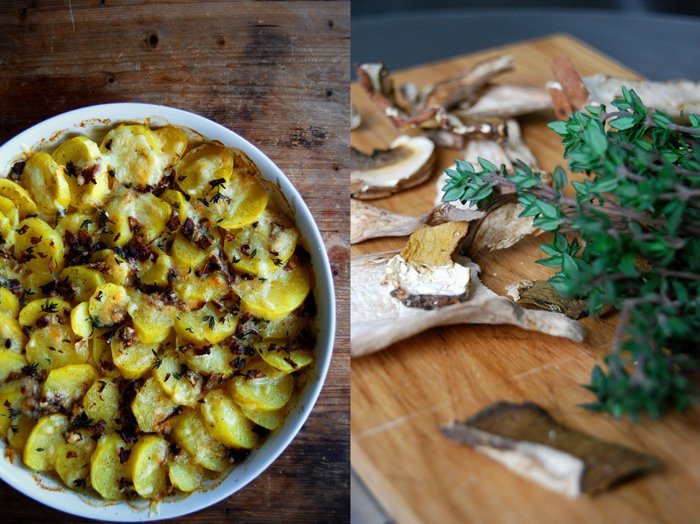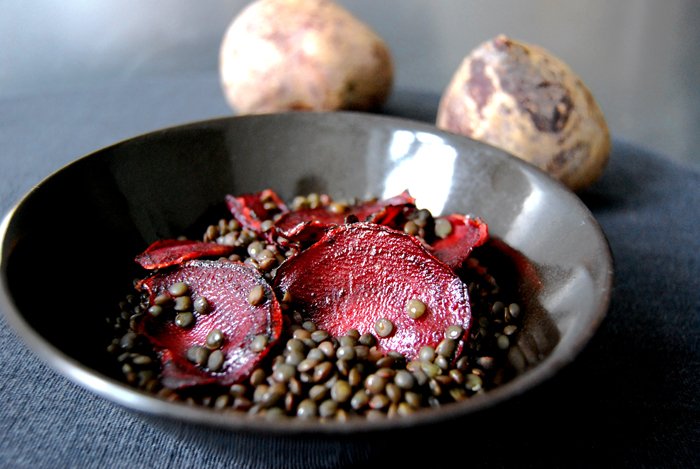A Monday Morning Juice with Grapefruit, Banana, Orange and Ginger
I have the tendency to become overly excited as soon as the temperature rises above 10°C and the sun comes through for more than a couple hours. I know it's only the beginning of March but I already feel like spring. I want to get out my summer clothes and jump around in the springy, fresh air. I want to sit outside a café with a glass of chilled white wine, enjoying the warm sun. Unfortunately, there's still a gap in temperature between my dreams and reality which I don't want to accept (sometimes) and that's exactly the problem! I'm prepared for the coldest winter and arctic temperatures, I never get a cold, but at this time of the year, a stone's throw away from the end of the cold season, I tend to be too carefree and strain my immune system.
To avoid any deficit in vitamins, I start the week off with a powerful juice made of grapefruit, banana, blood orange and ginger. For two glasses of juice (400ml in all), I squeeze 1 pink grapefruit and 3 oranges. I add 1/8 teaspoon of grated ginger and half a banana, mashed smoothly with a fork. You can use a whole one but I didn't want its taste and sweetness to be too overpowering.
It's a true energy boost, like my January's Turmeric and Ginger Blood Orange Juice!
Carnival and a Cauliflower Soup with Ginger and Lemon
A couple weeks ago I wrote about our traditional family feast, a time when we all meet at my mother's house in the countryside to celebrate carnival. It's always silly, loud and involves lots of good food. The festive highlight is the making of our Berliner which involves each family member. A Berliner is a sweet speciality which looks a bit like a doughnut without a hole. It’s made of yeast dough, filled with jam, deep fried in vegetable shortening and sprinkled with cinnamon icing sugar. The jam filling changes with the years, a few weeks ago I filled mine with blueberry jam which became my favourite (for now), they tasted divine! The reason I made them at my home without my family before carnival, was a blog tour I was asked to joined. I decided to share our "Berliner" family tradition. I made them on my own for the first time in my life, they were as good as at my mother's but it's more fun with family and friends.
In the end it turned out to be (subconsciously) a wise choice as this carnival will be different. This year there is neither a family feast nor a Berliner to enjoy, for us it's soup instead. A wisdom tooth got in our way and needed to come out quick. Needless to say, a jam filled Berliner isn't the appropriate food in a situation like this, porridge and soup is more like it!
I have a big, beautiful cauliflower in the kitchen, a cabbage I don't use so often but in a velvety soup it shows its finer qualities. The sweet taste and smooth texture is great for puréed soups. I don't add any cream, just broth, onion, garlic and some tangy flavours, lemon and ginger. A piece of ginger simmers together with the cauliflower in the broth before I season it with grated ginger to taste. I add the lemon's juice and zest when the soup is done, arrange it in plates drizzled with some good olive oil and sprinkle some more lemon zest on top. I'm impressed, it's still smooth but fresh!
Last week I told you that eat in my kitchen was nominated for The Kitchn's Best Daily Read Cooking Blog Award 2014. Food52 won the award but I want to thank you all for your support and all your votes, with your help eat in my kitchen reached the final!
Ginger Lemon Cauliflower Soup
For 4 people you need
a big cauliflower, rinsed and cut into 5cm / 2" pieces, around 750g / 1.5 pounds (weight without stem)
vegetable broth 1500ml
onion, chopped, 1
garlic, cut in half, 1
bay leaf 1ginger, thumbnail sized piece plus 1 teaspoon grated
lemon juice 1 tablespoon
lemon zest 1 teaspoon
salt and black pepper
olive oil for frying and topping
In a large pot, fry the onion and garlic in a little oil until golden and soft. Add the cauliflower, bay leaf, the piece of ginger and broth and bring to the boil. Cook for 10 minutes or until the cauliflower is al dente. When it's done take out the bay leaf and ginger and put a few smaller pieces of cauliflower (a small plate full) aside before you mix the soup in a blender. Season with salt, pepper, the grated ginger, lemon juice and zest and put the cauliflower pieces back into the smooth soup. When you arrange the plates, drizzle some good olive oil on top and sprinkle with some lemon zest.
A Bittersweet Chicory Grapefruit Salad
My lunch looks like summer, bright pink and yellow, a glowing sunset on the table! I got my Mediterranean plates out to make the holiday feeling complete. This is a quick salad, it doesn't require many ingredients or much time. It's a variation on my Chicory Pear and Walnut Salad, but this time I combine the crunchy chicory with the bitter sweetness of pink grapefruit. It's lighter, more like spring. Full of vitamins, this mix refreshes the body and mind within seconds!
For a salad for 2 (as a side dish) I cut 2 chicories in half and then into thick slices. I mixed them with the juicy bite sized pieces of half a pink grapefruit, you can use more but I wanted more leaves than fruit on the plates. My dressing is also simple and quick to prepare, 3 small tablespoons of olive oil mixed with 2 small tablespoons of white Basamico vinegar, seasoned with salt and pepper. I drizzled it carefully over my salad, just enough to glaze the leaves and fruit. Too much of the dressing would cover the salad's sweet bitterness with sourness, they have to keep a balance.
Fougasse Sandwich with Baked Beetroot, Goat Cheese and Thyme
I got really hooked on the roots and syrup combination in the past week. It all started with my ginger honey glazed Navet, yellow turnip fried as vegetarian steaks followed by caramelised maple parsnip with goat cheese combined in a warm salad and I'm still in the mood for sweet and earthy duos, at least one more.
It's Sandwich Wednesday and the first thing that came into my mind when I looked at the beautiful Fougasse bread I baked yesterday, was a baked beetroot sandwich. My flatbread has strong aromas of orange and sage, perfect to add some more earthy and sweet flavours. There are some beetroots lying on my kitchen window sill, just waiting to be baked in maple syrup and olive oil sprinkled with thyme. I found a kind of thyme at the organic store that I have never seen before, with thick, long leaves. They are stronger in taste compared to the small leaved one, a bit woody. The thin slices of the roots are done after 10 minutes in the oven, soft, syrupy and partly crisp. I let them soak into the oily bread and finish my sandwich with some mild goat cheese crumbled on top to add some fresh milkiness.
I made 3 flatbread sandwiches with 3 small beetroots peeled and cut into very thin slices and mixed with 3 tablespoons of olive oil and 2 tablespoons of maple syrup. I seasoned the roots with salt and pepper, mixed them with a few sprigs of thyme and roasted them spread in a roasting tin for 12 minutes in the hot oven set to 220°C / 430°F (Rotitherm roasting setting) until they were soft.
If you don't want to make your own Orange Sage Fougasse bread (I can just recommend it as it's fantastic), you can also use focaccia or soft buns (I made some very soft and juicy Mountain Buns with spices a couple months ago). I cut the flatbread in half, drizzled some olive oil (generously) on one side and spread the roast beetroot slices on top. After I sprinkled them with goat cheese (for 3 sandwiches I used 100g / 3.5 ounces of cheese), some fresh thyme leaves, salt and pepper, I closed my Fougasse sandwich, pleased about another great sweet root variation!
Fougasse Bread with Orange, Sage and Olive Oil
It's time to bake bread again! I use a recipe which involves sage and my beloved blood oranges, they'll be out of season soon, so I'm using every possible occasion that allows me to cook or bake with my sweet citrus fruits. I mix generous amounts of their zest and juice into the dough and the result is impressive!
My bread is a light and aromatic Fougasse, a French flatbread very popular in Provence where it's often made with olives, herbs and cheese. It's similar to the Italian Focaccia but with a leaf pattern of cuts in the dough. In some recipes, the cut goes all the way through creating holes in the bread while it's baking which makes the bread harder. I prefer to leave mine juicy with shallow cuts on the surface. Besides the orange and sage I add good olive oil in and on the bread. I use the wonderful extra virgin olive oil from the Molise region which I got from Marilena. Its strong and fruity taste is just what my Mediterranean flatbread needs!
I already have a great idea for a sandwich I can make with this bread for tomorrow's Sandwich Wednesday!
Fougasse with Orange, Sage and Olive Oil
For 6 flatbreads you need
plain flour 400g / 14 ounces (I use spelt flour type 630 but you can use any other plain flour)
dry yeast 1 package (for 500g / 1 pound flour)
salt 1 teaspoon
fresh sage, chopped, 8-10 leaves
zest of 1 medium sized orange
freshly squeezed blood orange or orange juice 100ml
water, lukewarm, 100ml
olive oil 5 tablespoons plus more for brushing the bread
organic egg 1
Combine the flour, yeast, salt, orange zest and sage in a large bowl. Add the water, orange juice and egg and mix with your dough hooks for 5 minutes. On a floured surface, continue kneading with your hands for a few minutes until you have an elastic dough ball. Put the dough back into the bowl and cover with a tea towel. Let the dough rise in a 35°C / 95°F warm oven for 45 minutes. This works really well but make sure that your oven is set to top/ bottom heat and not to fan.
Take the dough out and punch it down. Divide it into 6 pieces and roll them out into egg shaped discs (on a floured working surface, around 1 1/2 cm / 1/2″ thick). Put them on a baking sheet lined with parchment paper, cover with a tea towel and let them rise for 20 minutes.
Set your oven to 210°C / 410°F.
Brush the flatbread with olive oil and cut a pattern of 6-8 diagonal slashes into the dough to make a leaf pattern. Bake the flatbread on the lowest level for 12-15 minutes or until golden brown. Take them out and let them cool for 2 minutes.
I cut the warm flatbread in half and drizzled some more olive oil over it, it merged perfectly with the orange and sage aromas!
An earthy Chard and Ricotta Lasagna
One of the qualities of chard, besides its wonderful taste, is that it gives me a spring feeling even in the coldest and darkest February evening. The thick green leaves are a promising hint of all the fresh green which will be on my plate in the next months, but for now I gladly enjoy this versatile vegetable. Chard tastes similar to spinach, but stronger with earthy flavours. I like it in combination with pasta and milky cheese. For a quick and easy dinner I chop the leaves roughly, cut the thicker stems into very thin slices, fry them in oil and deglaze everything with a glass of white wine. Mixed with spaghetti, some heavy cream and parmesan it's a wonderful pasta dish.
With a bit more time, chard makes a delicious lasagna together with ricotta, Béchamel and some parmesan. For a cold night, I recommend this comfortable dish. It's done after less than half an hour in the oven, you just need to blanch the chard beforehand and prepare the Béchamel.
Chard and Ricotta Lasagna
I use a 27cm x 20cm / 10.5″ x 8″ baking dish, definitely big enough for 4 people.
For the chard
chard, rinsed, 500g / 18 ounces
nutmeg, ground
salt and black pepper
Bring a large pot with water to the boil. Cut the soft green of the chard into 1 cm / 1/2" strips and the hard white parts into very thin slices. Salt the water, first boil the white slices of chard for a couple minutes until al dente, then throw in the the green as well and cook for 1 minute. Take the chard out of the water and rinse in a sieve with cold water for 1-2 seconds. Season with salt, pepper and nutmeg to taste and set aside.
For the Sauce Béchamel
milk 600ml
butter, 30g / 1 ounce
plain flour 30g / 1 ounce
bay leaf 1
a pinch of nutmeg, grated
salt and black pepper
Mix the milk with the nutmeg, salt and pepper and bring to the boil. In a sauce pan, melt the butter and whisk in the flour. Pour the hot milk into the roux and continue mixing till smooth. Add the bay leaf and simmer for around 5 minutes on low heat until the texture is thick and smooth. Take the bay leaf out and season with salt and pepper.
For the Lasagna
lasagna pasta sheets around 250g / 9 ounces
ricotta 250g / 9 ounces
Parmesan, grated, 4-6 tablespoons
Set the oven to 180°C / 355°F and butter the baking dish.
Put down a layer of pasta in the baking dish, spread with 1/2 the chard, pour 1/3 of the Béchamel over it and sprinkle with 1/2 of the ricotta (in big lumps). Repeat with another layer of pasta, the rest of the chard and ricotta and 1/3 of the Béchamel, cover with the final layer of pasta and the remaining Béchamel. Sprinkle with parmesan. Bake for 25 minutes or until the pasta is done, switch on the grill for 2 minutes or until the pasta becomes golden brown and partially crisp.
Sweet and Spongy Banana Chocolate Bread
This is another perfect weekend breakfast treat, Banana Chocolate Bread. I like mine juicy, almost moist, with lots of big pieces of banana and bittersweet chocolate chunks. When you take the bread out of the oven, golden and warm and you cut the first thick slice off the loaf, pushing the knife through sweet banana chunks and melted chocolate, you'll understand why there's no better start to the weekend. It feels, smells and tastes just right! I never wait for the bread and chocolate to cool, I have to eat a slice immediately as soon as it's done, the chocolate still warm and liquid.
The combination of banana and bittersweet chocolate is a special one as the sweetness and the bitterness balance each other out perfectly. I love it in ice cream, cookies and cakes, but to me nothing beats this duo when their big chunks merge into a warm cake, or morning bread. For one loaf I use three big bananas and 100g / 3.5 ounces of bittersweet chocolate, I don't want a hint of their flavours, I want an explosion on the taste buds.
Banana Chocolate Bread
For a 24cm x 10,5cm / 9.5″ x 4″ loaf tin you need
butter 120g / 4.5 ounces
granulated sugar 100g / 3.5 ounces
vanilla sugar 1 package (you can also use vanilla extract)
organic eggs 2
large and ripe bananas, quartered, 3
plain flour 120g / 4.5 ounces
baking powder 2 teaspoons
salt 1/2 teaspoon
bittersweet chocolate, chopped roughly (leave a few bigger chunks), 100g / 3.5 ounces
Set the oven to 160°C / 320°F (fan-assisted oven) and line the loaf tin with parchment paper.
Combine the flour, baking powder and salt. Mix the butter together with the sugar and vanilla sugar till fluffy. Add the eggs, one at a time, and continue beating for a couple minutes. Add the bananas, beating for 10-20 seconds and stop before they get too smooth, they should be a bit chunky. Gently fold in the flour mixture with a spoon, add the chocolate chunks and fold them in, carefully as well. Scoop the dough into your prepared tin and bake for 55 minutes or until golden brown. Check with a skewer, it should come out clean.
A Salad of Caramelised Parsnip with Maple Syrup, Goat Cheese and Thyme
At the moment I could eat roots and turnips all the time luckily, as tasty spring vegetables are still a few months away. It's always the same, around March I start to miss ripe tomatoes, juicy cucumber, crunchy lettuce, zucchini, the ripe tastes of summer. Greenhouse vegetables reach their watery peak at this time of the year so they are not really an alternative. The cherry tomatoes I bought the other day had thick skin and when I ate them I had to image tomatoes rather than tasting them. I don't really feel like cabbage anymore, so I stick to everything that grows in the ground.
I enjoyed my Monday's Ginger Honey Navet Steaks so much, their sweet, syrupy juices were delicious, that I thought about other combinations of roots and syrup. My choice was caramelized parsnip roasted with maple syrup and thyme leaves, combined with fresh goat cheese in a warm salad. The juices make a great thick syrup, glazed around the roots they are a perfect match for the milky cheese crumbs and strong wintery herb. You could make it as a side dish, still hot, we ate it as a warm salad, I didn't want the cheese to melt.
I cut three parsnips into long strips and glazed them with 3 tablespoons of olive oil and 2 tablespoons of maple syrup mixed with salt and pepper. A dash of white wine and the leaves of 4 sprigs of time on top, everything well spread in a roasting tin, I baked it for 15 minutes in the hot oven set to 200°C / 390°F, Rotitherm roasting setting. When the parsnip was done, golden on the outside and soft inside, I let them cool for a couple minutes before I crumbled 80g / 3 ounces of fresh, soft goat cheese over the roots. The two us cleaned the tin with our fingers, not to waste a drop of the sweet syrup.
Crunchy Artichoke Hearts with Spinach Tagliatelle
I had three artichokes left from Emma's wonderful gift from Malta, where they are already in season. I kept them to cook a meal which I usually enjoy in late summer, artichoke fried with onion and garlic mixed with pasta. I remove their leaves and use just their heart and stem, cut into thin slices as opposed to the bigger, round ones which have thicker, fleshy leaves, perfect to dip into dressings and nibble on, also a summer treat I look forward to!
As soon as the leaves have been removed from the artichoke, this meal is really quick to cook. First I prepared the three vegetables which are enough for a dinner for 3. When you pull the leaves off and cut out the fine hair, you can keep the artichoke heart and stem in a bowl with water and half a lemon. This keeps them from changing their colour as you continue preparing the rest of them. I didn't do this as I don't mind.
I went for Delverde Tagliatelle Agli Spinaci (around 300g / 10.5 ounces) to bring in some colour and cooked them al dente while I prepared the artichokes. First I fried 1 finely chopped onion and 1 crushed garlic in some olive oil in a large pan until golden and soft. I added the finely sliced artichoke and fried it until golden brown on all sides. I deglazed it with some white wine, seasoned with salt and pepper and let it cook for a few minutes. When the tagliatelle were done, I poured some of the water I used for cooking the pasta over the artichokes, mixed in the pasta and seasoned everything with salt and black pepper to taste.
Ginger Honey glazed Navet Steaks with Orange Juice and Rosemary
When I saw these beautiful yellow turnips, also known as Navet, at the store, I had to buy them although I wasn't really sure what to cook with them. They are related to beetroot but taste more like rutabaga. After 1 or 2 days of looking at them I found my inspiration, thick Navet steaks fried in butter with ginger, honey, orange juice and rosemary. I made a similar recipe with rutabaga in December and the combination of turnip and ginger is one that I like a lot.
This time, I wanted to add a few more aromas, the sweetness of honey, the fruity sourness of orange juice and some woody rosemary, all this combined in the buttery juices of my yellow turnip. The result left me speechless! I couldn't get enough of this sauce, so thick, sweet, spicy and sour, simply amazing, and the Navet steaks covered in this sticky glaze combined perfectly with all the different flavours.
Ginger Honey glazed Navet Roots with Orange Juice and Rosemary
For a lunch or side dish for 2 you need
yellow turnip, cut into thick steaks, 2 (you can also use rutabaga)
ginger, grated, a thumbnail sized piece
honey, 1 teaspoon
orange juice for deglazing
fresh rosemary, chopped, 2 tablespoons
butter 3 tablespoons
salt and black pepper
In a large pan, heat the butter together with the honey and ginger, add the turnip and season with salt and pepper. On medium heat, fry for 2-3 minutes on each side until golden brown. Deglaze with a splash of orange juice, let it cook for 1-2 minutes and sprinkle with rosemary.
Earthy Porcini Lentil Soup with Honey and Ginger
A couple days ago I ate a very aromatic porcini soup at one of my favourite restaurants and I was very surprised when the chef and owner told me where the mushrooms for this wonderful meal came from, the desert. The dunes of the Kalahari in southern Africa produce sensational truffle and porcini in season from now till May. I savored this dinner together with my family and we were all surprised and impressed at the same time! I've never seen mushrooms from the Kalahari in a store or at the markets before but I will definitely look out for them!
The soup was so tasty that it aroused my appetite for mushrooms and I had to think of a lentil soup my aunt Ursula had told me about (she was at the dinner as well). It combines the earthy flavours of lentils and porcini. I went for dried porcini (from Italy not from Africa). My aunt recommended them for this meal as you have to shred them finely into a very concentrated porcini flour which you cook together with the lentils. I used my Swabian Alb Leisa Lentils from South Germany for this meal which conveniently don't need to soak in water. Their taste is strong enough for the aromatic porcini, so strong that I could even add a piece of ginger, some thyme sprigs and a spoon of honey. The result is an absolutely delicious lentil soup full of wintery aromas.
Porcini Lentils with Honey, Ginger and Thyme
This is great to cook in large batches to keep in the freezer for quick dinners!
For 4 people you need
lentils 350g / 12.5 ounces (I use a small dark type which doesn't need to soak)
dried porcini mushrooms, shredded finely in a blender, 50g / 2 ounces
medium sized onion, chopped, 1
garlic, crushed, 1 clove
broth 1000ml plus more for cooking depending on the lentils
fresh thyme 5 sprigs
ginger, thumbnail sized
bay leaf 1
honey 1 tablespoon
salt and black pepper
olive oil for frying
In a large pot, fry the onion and garlic in a little oil on medium heat until golden, add some more oil and the shredded porcini and fry for 1 minute. Add the lentils, ginger, thyme, bay leaf and the broth. Don’t season with salt yet or the lentils will stay hard. Close the lid and let it cook for about 30 minutes. The cooking time depends on the lentil type, mine needed 30 minutes. When the lentils are soft, add the honey, season with salt and pepper and take out the thyme sprigs, bay leaf and ginger.
A Purple Risotto with Bitter Radicchio
When it comes to risotto I like the rice to have a bit of bite, with a velvety texture and not too liquid. I always make mine with broth and wine adding a little at a time so that I don't miss the point of my favoured texture. What's great about this meal is that it's made of ingredients which I usually have in stock. There are always one or two vegetables in my fridge waiting to be used and Arborio rice, onions, garlic, olive oil and wine to cook is on my shelves anyway. So it's perfect for an indecisive day when I don't know what to put on my cooker, or I don't have the time to think about dinner. Conveniently, it's also ready in half an hour!
My purple risotto has a biting bitterness from the radicchio which combines very well with the thyme. The rice is infused with the strong flavours in my broth and spices. I use a bay leaf and cloves which introduce a woody element to the bitterness (although that sounds strange, it describes it best!). When I cook with radicchio I like to have a strong counterpart to balance out its dominant character.
Radicchio Risotto with Spices and Thyme
For 2 hungry people you need
Arborio rice 200g / 7 ounces
radicchio, quartered and cut into slices, 1 medium sized head (I cut a few radicchio slices very thinly which I leave uncooked for the topping)
onion, chopped finely, 1
garlic, cut in half, 1 clove
red wine around 200ml
broth 1200-1500ml
fresh thyme leaves from 4-6 sprigs
bay leaf 1
cloves 2
salt and black pepper
olive oil for frying
butter 1 tablespoon
In a large pot, fry the onions and garlic in a little olive oil until golden and soft, stir in the rice and radicchio and fry on medium temperature for a couple minutes. Deglaze with 1/3 of the wine, let it cook until evaporated and repeat twice, stirring in between. Add 4 sprigs of the thyme, the spices, salt and pepper and some of the stock, enough to cover the rice. The temperature should be between low and medium. When the liquid has been absorbed continue to add more broth, a little at a time stirring in between. Depending on the rice, it sometimes needs more or less liquids. When the rice is al dente and the broth is more or less absorbed take it off the heat, take out the spices, stir in the butter and season with salt and pepper to taste. Arrange on plates sprinkled with the uncooked radicchio slices and some thyme leaves.
Beetroot and Apple Carpaccio with Pomegranate
A quick carpaccio in bright red with cooked beetroot, apple and pomegranate to welcome a special guest! My mother will be at my home (and in my kitchen) over the next few days. I'm sure we'll be out a lot but I really hope we'll find some time to cook together which I enjoy a lot!
I'm a big fan of vegetable carpaccio. It allows you to combine different flavours in a very pure, quick to make and beautiful way. All you have to do is slice a vegetable or fruit very thinly, arrange it and top with a simple dressing. My red carpaccio is based on the strong, earthy-sweet taste of cooked beetroot which combines perfectly with the sweetness of the apple and pomegranate. I cooked the roots in a bigger batch - as I do every week - in salty water with two bay leaves for 50 minutes (depending on their size they might need shorter but mine were big). For my carpaccio for 2 I need 1 root cut thinly with a slicer, 1 sweet apple prepared in the same way and the seeds of 1/3 of a pomegranate. I drizzle my current favourite lunchtime dressing on top, 3 tablespoons of olive oil mixed with 2 tablespoons of white Balasamico and season it with salt and pepper. It's a great lunch, as pretty as it is tasty!
A warming Soup with Chestnuts, Cinnamon and Thyme
For this soup I appreciate the convenience of vacuum packed peeled chestnuts - even though I love the romantic, wintery atmosphere when you bake them in the oven and they fill the air with the smell of their burned peel. I need quite a few nuts for my recipe and with so many to peel, the thought of burnt fingers puts me off. I want a soup without major frustration and injury, so I bought them pre-cooked and peeled. This is a quick soup, relaxed cooking and I didn't want to change that.
I had a velvety soup in mind, smooth and a bit sweet, enhanced with some cinnamon and thyme. I wasn't sure if the chestnuts would be too overpowering so I added a few cooked potatoes. When you have a nice broth on hand, the preparation only takes a few minutes. All you need to do is fry an onion in a little oil, add the chestnuts, potatoes, cinnamon and thyme and heat everything together with the broth, some cream, salt and pepper. When you have everything together, mix it in a blender.
As a main for 2, I used 250g / 9 ounces chestnuts, 3 medium sized cooked potatoes (cut into cubes), 1 large onion (chopped and fried in olive oil), 600ml of broth, 1 tablespoon of heavy cream, seasoned with 1/2 a teaspoon of cinnamon plus salt and black pepper to taste. Fill into bowls and if you like sprinkle with chestnut crumbles, cinnamon and thyme.
Sandwich Wednesday with Camembert and Juicy Pomegranate
It felt like a lot of people enjoyed my Stilton and Pear Sandwich a couple weeks ago as much as I did. I received quite a few messages from people who tried it and loved it which made me think about further possible cheese and fruit combinations. There are a million variations but I particularly love a mix of sweet and aromatic flavours. When it comes to cheese, I'm the kind of person who eats what others might consider to be beyond the expiry date, to me a cheese can't be too ripe. There is a wonderful cheese section in my favourite department store which has - as you can imagine - a very distinct smell in the air. So when I go there with friends you can be sure that when the others are already on the run, I'm still standing there fascinated by the variety. When it comes to cheese, I feel no pain!
At the moment I buy a lot of pomegranate, they are sweet and juicy (and full of antioxidants which isn't bad either). So the fruit is set. My cheese of choice is an an aged Camembert, so stinky that I have to wrap it twice and put into a box to keep the rest of my fridge safe, but it tastes delicious! I bought a loaf of Ciabatta, my current favourite for sandwiches when I don't bake my own bread, which I cut in half and cover with thick slices of my creamy Camembert (for 2 people I needed around 90g of this cheese). I baked it in the oven under the grill for just 20 seconds, any longer and there wouldn't be any cheese left. This one melts really quick! I kept a baking dish under it to collect the cheese running down the sides of the bread. When it was golden brown, I took it out and sprinkled my sandwiches with the seeds of 1/3 of a pomegranate and crushed black pepper.
Sweet Pear and Bitter Chicory Salad
This was my favourite salad during my university years! When I was too busy to cook or my fridge didn't have much to offer, this was always an option (besides spaghetti with tomato sauce). A crunchy sweet and bitter combination which I always love but here especially together with the walnuts. In winter I make sure I have these three in stock, pear and walnuts as a quick snack and chicory is one of my quick emergency dinners. If I'm running out of time, I cut 2 chicories in half, fry them in butter, golden brown on each side and season them with salt and pepper - done.
For my salad I need 2 chicories and 1 pear, both sliced in strips, enough to feed 2-4 people. At lunch time people have different eating habits so it's hard to estimate the exact amounts. At a dinner party this is definitely enough for a a side dish for 4. I make a light dressing with 3 tablespoons of olive oil mixed with 2 tablespoons of white Balsamico (I can't live without this vinegar in winter!), seasoned with salt and pepper. You could also add some fresh lemon juice. Some walnuts on top and I'm back in my student years!
Potato Porcini Gratin with Raclette and Thyme
Imagine bubbling Raclette cheese, golden potatoes, earthy Porcini and aromatic thyme and you have all the strong but well balanced flavours of my hearty gratin. Add some cream, salt, pepper and nutmeg and you're pretty much done. It's a quick one, the potatoes are boiled already and I used dried Porcini which only had to soak for a couple minutes. Normally I make my gratin with raw potatoes, sliced very thinly, several layers stacked on top of each other with cheese in between. It takes longer to prepare and to cook, I didn't have the time so I went for a quicker one.
I like to cook with dried Porcini. It's convenient as you can use them all year round and they are really tasty, even more intense than the fresh ones. I always use the liquid after I soak them in water as it absorbs lots of the mushroom's taste. It's great for risotto or, in my case, to mix with the cream. It makes a lighter sauce than my usual gratin milk and cream mixture. I add some thyme which is the perfect herb for Porcini (parsley also fits well but the thick thyme leaves give it this nice wintery touch). I cut the potato slices quite thick, I don't want them to become mushy when they soak a bit of the sauce. To finish it off it just needs some strong meltable cheese sprinkled on top. Swiss Raclette became one of my my favourites over the past years as it tastes really strong. I don't like to drown my poor food under piles of cheese for a bit of taste, I rather use less of a good and aromatic one.
Potato Porcini Gratin
For 4 people as a side dish, or for 2 as a main, you need
boiled potatoes, cut into thick slices, 800g / 1 1/2 pound
dried Porcini, soaked in 120ml of warm water, chopped, 20g / 1 ounce (keep the water, you will need 100ml for the sauce)
heavy cream 100ml
Raclette cheese, grated, 50g / 2 ounces
thyme leaves of 2-3 sprigs
salt and black pepper
nutmeg, ground
olive oil to brush the baking dish
Set the oven to 200°C / 390°F.
Arrange the potato slices in the oiled baking dish. Mix the cream, Porcini water, chopped Porcini, cheese and thyme leaves. Season with salt, pepper and nutmeg and pour over the potatoes. Bake for 30 minutes or until bubbly and golden. At that point you can also put the gratin under the grill for a couple minutes so that the cheese becomes a bit crisp.
Sabih - A Sandwich with Hummus, Egg and Grilled Aubergine
The last time I ate Hummus at a restaurant I decided that the time has come to make my own. It's one of my favourites from the Middle Eastern cuisine and you can be sure that I always order my own little bowl of this delicious spread when we go to a restaurant to make sure that I definitely have enough for myself.
I'm an expert when it comes to eating it but not preparing it and I didn't want to make a fool of myself so I decided to ask two experts, both very good friends of mine from Israel. They recommended using really good quality Tahini from Lebanon because this sesame paste has a big influence on the Hummus' taste. It's one of the main ingredients together with cooked chickpeas and this is actually where Hummus gets its name from, meaning chickpeas in Arabic. It's very easy to prepare if you use tinned chickpeas - that's what I did and the expert opinions didn't object - you just have to peel them which only takes 5 minutes. It's more like popping them out of their peel between two fingers, it's fun! Then you add the Tahini, fresh lemon juice, garlic, salt, water, mix everything in a blender and your Hummus is done.
My friends also told me about a sandwich which is very popular in Israel - Sabih (meaning the handsome one!). You spread Hummus on some good white bread (I use my olive bread which fits really well with its juicy texture and flavours of green and black olives), then you put slices of grilled aubergine and boiled egg on the Hummus and sprinkle some Harissa on top. This is too good! I'm not normally the first one to put an egg on a sandwich, but here I make an exception. The creamy Hummus, the juicy bread, the aubergine, the egg, the whole combination is just divine, I'm not surprised this sandwich is so popular!
Sabih with Hummus, Grilled Aubergine and Boiled Egg
I made enough Hummus to fill a large bowl as you can keep it in the fridge for a few days. For the sandwich you can also use white flatbread but I must say that I really enjoyed it with my thick and juicy olive bread.
For the Hummus
canned chickpeas, cooked and peeled, 475g / 17 ounces
tahini 300g / 10.5 ounces
garlic, crushed, 2 big cloves
salt 1 1/4 teaspoon
freshly squeezed lemon juice 5 tablespoons
water 100-125ml
olive oil, for the topping
harissa, for the topping
Purée all the ingredients in a blender until you have a smooth paste, you can add a little more water and lemon juice if you want the Hummus less thick. Fill in a bowl and sprinkle with olive oil and Harissa.
For the grilled aubergine (eggplant)
one aubergine, cut into 7mm / 1/4" slices
olive oil to brush the aubergine slices (around 50ml)
salt and pepper
Brush the aubergine slices with olive oil, season with salt and pepper and grill in the oven until golden brown and soft.
For the sandwich
white bread, 4-6 thick slices
boiled organic eggs, cut into slices, 2
Spread the Hummus on a slice of bread, put 1-2 slices of the grilled aubergine and some of the egg on top and sprinkle with a little Harissa to add more spiciness. Close with a second slice of bread to finish your sandwich.
A Salad with Beluga Lentils and Beetroot
I went a bit overboard on the weekend, two pies (sweet and savory) in two days, time for a change in my kitchen! Something lighter (that doesn't involve butter) is on my mind, a salad with black Beluga lentils and fried beetroot slices. Beluga lentils are perfect for salads. They are tiny little legumes, with a strong and nutty taste and they just have to cook for 30 minutes without having to soak in water. The beetroot becomes a bit sweet when you fry the raw slices, even sweeter than when boiled in water. When it comes to salads, I prefer fewer ingredients with strong flavours and quick preparation. I'm not too fond of salads which mix up lots of different vegetables and fruit as the single tastes tend to get blurred.
Today's salad is a dark beauty, the lentils are dark grey, nearly black with shades of blue and green and the beetroot slices deepen to a dark red when you fry them. All you need for a salad for 4 is 1 cup / 200g of Beluga lentils, rinsed and cooked in 3 cups of water (without salt!) for 20-30 minutes. While they are simmering, I slice 2 large uncooked beetroots with a slicer very thinly. I heat some oil in a large pan, sprinkle the beetroot slices with a pinch of sugar and fry them in batches for a few seconds on each side before I season them with salt and pepper. They burn quickly which gives them a bitter taste so you have to watch them.
My dressing is very simple and light, 3 generous tablespoons of olive oil mixed with 1 tablespoon of freshly squeezed lemon juice and 1 tablespoon of white Balsamico vinegar, seasoned with salt and black pepper. When the lentils are done I rinse them with cold water, drain them and pour the dressing on top. You may have to add more salt and pepper at this point to taste. I lay the beetroot slices on top and the salad is ready to be served!
Buttery Crisp Fennel Tart
A tart, a quiche, a pie, call it whatever you like, anything that involves buttery short crust is heavenly food to me. I'm the happiest person in the world when I have one of these in my oven, filling the air with that buttery smell, teasing me as I can't wait to have the first bite in my mouth. Most of the time I use my all time favourite quiche crust recipe for any kind of savory tart or quiche. I wrote about that recipe in December. It has been with me for nearly twenty years and I never found a better one. It's crisp, it's buttery, yet still light. Just perfect!
If you follow eat in my kitchen you'll find that I tend to buy too much of this and that (I'm talking about food). This time it's fennel, three bulbs! I never throw any food away, I use everything I buy, but I become too excited when I see all the nice food at the market and a million things come into my mind that I'd like to cook with them. So I buy whatever arouses my appetite. Sometimes, my fridge just reaches its limits.
I haven't made a tart in a while so I will use the fennel for the filling, mixed with Parmesan, a few eggs, milk and cream, and the buttery smell can take over my flat!
Fennel Tart
For one tart you need a round (27cm / 10.5″) or oval baking dish or tart pan.
For the short crust base
flour 250g / 8.5 ounces (I use spelt flour type 630 but you can use any other plain flour)
butter, cold 125g / 4.5 ounces
organic egg 1
salt 1 teaspoon
Combine the flour with the salt. Cut the butter with a knife into the flour until there are just little pieces of butter left. Continue with your fingers and work the butter into the flour until combined (there shouldn’t be any lumps of butter left). Add the egg and continue mixing with the hooks of your mixer until you have a crumbly mixture. Form a disc, wrap in cling film and put in the freezer for 10 minutes.
For the filling
fennel, cut in half and sliced thinly, 400g / 14 ounces
organic eggs 2
milk 100 ml
heavy cream 100 ml
Parmesan, grated, 2 heaped tablespoons
salt 1 teaspoon
black pepper
nutmeg, freshly grated
The tart
Set your oven to 210°C / 410°F.
Sauté the fennel in a big pan in a little oil for 5 minutes until golden.
Mix the eggs with the milk, heavy cream, Parmesan, salt, pepper and nutmeg.
Roll out the dough between cling film and line your baking dish with the flat pastry. Prick it with a fork and blind-bake in the hot oven for 10 minutes. Take your baking dish out of the oven and set the temperature down to 180°C / 355°F.
Spread the fried fennel on top of the pre-baked pastry base and pour the liquid mixture over. Put the tart carefully on a baking sheet in the oven and bake for about 30 minutes or until golden, the top should be firm. Let it cool for 10 minutes.





